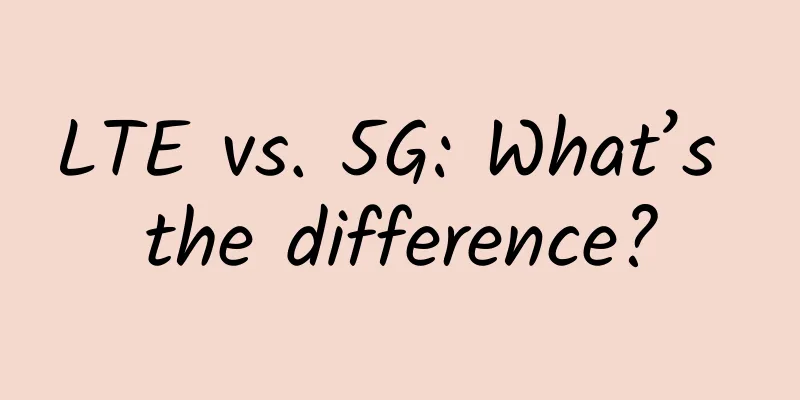When wireless communication officially becomes a strategic energy source: The butterfly flaps its wings in the 5G era

|
Speaking of 5G, what do you think of first? If you just think that it can make your phone faster, then I'm afraid you need more scientific knowledge. Indeed, after the 2G network became popular in smartphone service ports, Chinese consumers got used to the lifestyle of adding "one G" every few years. They think that more "G" does make the network faster. However, it should be noted that 4G networks have already shown signs of catalyzing qualitative changes in the entire industry. In the fields of mobile communications, video transmission, cloud + terminal services, etc., 4G has begun to bear the responsibility of being much faster and stronger than mobile network transmission speeds. 5G technology will almost inevitably face more challenges and accomplish the important task of advancing human life and production to a higher level. Is it really that mysterious? Today, let’s take a deep look at the history and present of 5G. I thought of this topic because I just attended the 5G summit held by Qualcomm, where Qualcomm announced that it would join hands with China Mobile and ZTE to conduct 5G new air interface experiments. The high-energy information delivered at this conference made me believe that I must learn and understand 5G with everyone as soon as possible, and more importantly, understand the Internet opportunities and new rules of survival in the 5G era. Time waits for no one. It is said that the revolutionary transmission speed of 5G technology will be dozens of times faster than 4G. If we are not careful, we may be left behind in this world of high-speed communication. [From quantitative change to qualitative change: 5G's strategic value far exceeds its predecessors] When talking about 5G, the most common sense mistake is to make a specious comparison between the improvement from 3G to 4G. This is like a horse-drawn carriage is faster than an ox-drawn carriage, and a car is faster than a horse-drawn carriage. However, the transportation and space revolution that cars can achieve is far beyond the reach of horse-drawn carriages. According to a research report by IHS, the emergence of 5G will become a fulcrum, allowing mobile technology to evolve from a technology with a transformative impact on personal communications to a truly general technology, and is expected to change the entire industry and economy. Why do you say that? On the one hand, the answer comes from the high-traffic general technology and reduced communication costs brought by 5G technology, which can effectively support the further rationalization of the industrial structure and strengthen the application scenarios of communication technology in human life and business; more importantly, the massive information transmission brought by 5G may catalyze the growth of multiple key technologies and even quickly achieve qualitative changes. Let me give you a few examples: 1. Business imagination of the Internet of Things. After previous mobile communication technologies met the transmission needs between people, 5G will be able to use high-power transmission to meet the information transmission needs between objects, opening up the possibility of human-machine interaction and the application of network interaction between machines. 5G provides not only ultra-high-speed and large-volume transmission, but also the stability of cellular data and the ability to penetrate scenarios, which is crucial to the commercialization of the Internet of Things. Second, qualitative change and upgrade of key technologies: In key technologies represented by unmanned driving, 5G can provide machine-cloud collaboration and ultra-fast response mechanisms. This will bring about qualitative changes in the transition from technology to application. In addition to unmanned driving, aerospace, drones, and unmanned underwater operations are also direct beneficiaries of 5G networks. 3. Large-scale realization of cloud computing: Connecting ports to the cloud is one of the main themes of the 4G era. However, current mobile communication technology cannot meet the needs of a large number of cloud and terminal collaboration. The 5G era will provide comprehensive support for cloud computing and big data. This will have great value for the country, government, economy, business, and life. 4. The underlying industry of artificial intelligence and deep perception: 5G also provides basic support for artificial intelligence operations such as deep learning and perception computing. In particular, it opens up the underlying space for big data applications of perception algorithms and the possibility of quantum computing. The era of artificial intelligence has arrived, and the value of 5G in it is extremely critical. In summary, 5G corresponds not only to life and business space, but also to the evolution of multiple key areas of human technology tools. For countries and enterprises, 5G is an important strategic resource and infrastructure. And this war preparation race has already begun impatiently.
[Faster than expected: Butterfly imagination of 5G advanced research and development] What will be the final result of this thriving 5G race? At present, this is a race with many players, including multiple communication giants, hardware (mobile phones and base station equipment) manufacturers, operators, Internet companies and scientific research institutions from China, the United States, Japan, South Korea and Europe. Regardless of the final qualifying results, we can at least know one thing clearly: 5G is definitely in the advanced research and development stage, and will come faster than we usually imagine, and its potential energy will be more rapid. For example, Qualcomm, which just announced the joint launch of the 5G new air interface experiment, has advanced layout and R&D capabilities in the 5G industry. So far, Qualcomm has laid out or achieved breakthroughs in core technologies related to the development of 5G, including: 5G modem solutions, MIMO, carrier aggregation, shared spectrum, Gigabit LTE, narrowband Internet of Things, etc. In terms of technical solutions such as eLAA, massive MIMO, low latency, enhanced broadcast, low latency time slot structure design, channel coding, C-V2X, etc., they are also at a very leading level in the industry. Last June, Qualcomm brought a new 5G new air interface prototype system and LTE IOT results to the Mobile World Congress held in Shanghai. Six months later, it brought interoperability tests and OTA field trials based on the 5G new air interface (5G NR) specification. In January this year (last month), Qualcomm, together with Telstra and Ericsson, realized the world's first gigabit-class LTE commercial network in Sydney, Australia, and achieved a gigabit downlink rate through carrier aggregation, high-order modulation and 4x4 MIMO technology. It can be seen that industry players have already brought 5G to the final stage of technology commercialization and application. This race may soon yield results, but the butterfly effect caused by 5G technology solutions is something truly worth looking forward to.
[A new way to open up globalization? Qualcomm, ZTE and China Mobile's 5G new air interface experiment. 】 What really caught my eye about Qualcomm's cooperation plan this time is that it has adopted a new strategic matrix for cooperation with ZTE and China Mobile. There are many points that can be interpreted. The three companies announced that they will jointly carry out a new 5G "air interface" experiment, which aims to build the most important connection link between mobile phones and base stations. Under the dual premise that spectrum resources are becoming increasingly scarce and the amount of data transmitted by 5G networks is very large, the air interface will become an extremely important data transfer link. The new air interface experiment announced by the three companies this time is bound to be closely related to the first 5G connection based on the 3GPP 5G New Air Interface (5G NR) standard work just announced by Qualcomm. Its main significance is to help promote a global unified 5G standard, achieve large-scale and rapid verification and commercial use of 5G new air interface technology, and enable 5G new air interface infrastructure and terminals that comply with the 3GPP Rel-15 standard to be ready to support the timely deployment of commercial networks. It is no longer the first time that Qualcomm has chosen to form a new "iron triangle" model with equipment (mobile phone) manufacturers and operators. This experiment will be based on China Mobile's 5G guidance requirements, using Qualcomm's terminal prototypes and ZTE's base station solutions to simulate real scenarios and support a wide range of 5G new air interface use cases and deployment scenarios. It can be seen that on the one hand, it is aimed at the application rules and commercial scenarios of the Chinese market with a high degree of simulation as a prerequisite; on the other hand, it also shows that Qualcomm attaches importance to the global value of the Chinese market and is willing to take more cooperative and market-win approaches to enter the 5G era. China Mobile's influence on industry standards and rules, coupled with ZTE's market application and adaptability, has enabled Qualcomm to form a new global alliance model as a provider of technical solutions and core chips. In the next 5G competition, this model may be adopted by more companies, and its ultimate result may help China lead the world in the 5G era. The imagination behind it is worth looking forward to. 【Conclusion】 4G changes life, 5G changes society. This is not just a slogan for hearing or making a certain technology. Based on the various internal solutions of 5G communication technology and the general evolution of related technologies, 5G is likely to change society more realistically and thoroughly than we think. We cannot predict what 5G will change, but instead of waiting, we should analyze and establish a systematic understanding. We will share more 5G-related content and information with you in the future, so stay tuned. |
<<: 5G is still a long way off, but some people are already discussing 6G
>>: After FTTH: Who will lead the development of the optical fiber and cable industry?
Recommend
Megalayer: Philippines/US/Singapore/Hong Kong VPS hosting, starting at 199 yuan per year
Megalayer is restocking VPS with special annual p...
HostHatch US VPS 40% off + 5 times the traffic, Los Angeles 1TB large hard drive starting at $33/year
HostHatch shared some of their recent work a few ...
Ministry of Industry and Information Technology: By 2023, the penetration rate of 5G individual users will exceed 40% and the number of users will exceed 560 million
[[410991]] Ministry of Industry and Information T...
Baidu can't stand it
Lao Lao Noodles Source: https://www.nowcoder.com/...
What are some use cases for network automation?
As the networks run by enterprises become increa...
HostYun Mid-Autumn Festival 12% off: Korean VPS monthly payment starts from 15.8 yuan, Hong Kong VPS monthly payment starts from 17.6 yuan
HostYun has launched a promotion during the Mid-A...
DiyVM: 50 yuan/month KVM-2GB/50GB/5M/Hong Kong CN2 & Japan & US data centers available
In the past 2022, DiyVM has made a series of chan...
Global 5G users will reach 3.5 billion by 2026
Globally, more than 1 billion people, or 15% of t...
Port security technology: Where is your network defense line?
Port Security Technology Background The enterpris...
Yecao Cloud: Hong Kong cloud server/VPS annual payment starts from 138 yuan, dedicated server starts from 299 yuan/month, BGP or CN2 line
Yecaoyun is a Chinese hosting company founded in ...
HostDare: 35% off KVM in Los Angeles, starting at $25.99/year
HostDare is a foreign VPS hosting company founded...
RepriseHosting: Seattle server $24.95/month-L5640/16G memory/1TB hard disk/10TB monthly traffic
RepriseHosting is a long-established hosting comp...
BGP.TO Japan servers start at 35% off, Singapore servers start at 25% off, monthly payment starts at $93
BGP.TO is currently offering promotions for serve...
Business Benefits of Fiber Optic Network Connectivity
As businesses expand globally to gain access to n...
![[11.11] Megalayer: 60% off Hong Kong/US high-defense servers, 60% off Hong Kong Alibaba/Huawei cloud hybrid servers, US servers 199 yuan/month](/upload/images/67cabd292c61f.webp)

![[Black Friday] RAKsmart: VPS flash sale from $0.99/month, cloud server flash sale from $1.99/month, dedicated server flash sale from $30/month](/upload/images/67cabced032b3.webp)






